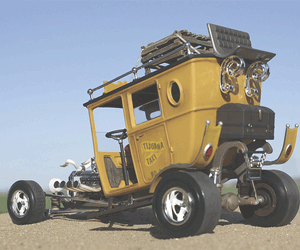LST (Landing Ship Tank) 1:245 Scale Lindberg Model Kit #HL213 Review
Right On Replicas, LLC Step-by-Step Review 20141210*
LST (Landing Ship Tank) 1:245 Scale Lindberg Model Kit #HL213 Review

Review and Photos by Alan Mann 
The LST, or Landing Ship Tank, was originally developed in World War II as a way of transporting tanks and trucks. LSTs first saw action in the Pacific theatre, and were extensively used in the 1944 D-Day landings by both British and American forces. By the end of the war the LST would find its way into every theater of the war serving as troop and vehicle transports, repair and supply ships, and even launching aircraft! Known to its crews as the “Large Slow Targetâ€, the LSTs were 328 feet long and sailed at only 9 knots! LST’s were built by shipyards across the US, including many that were sailed down the Ohio and Mississippi Rivers to the sea! The defensive armament of LSTs varied but was usually a mix of 40mm and 20mm AA guns sometimes with a 3″ gun at the stern. The LST was designed to run up onto the beach and then pull itself off by winching in an anchor dropped off the stern. It could hold tanks and trucks both inside and up on deck. Originally the ships used an electric elevator to access the deck but later ships used a ramp. There was also a cargo hatch in the deck forward of the aft superstructure for additional access below. LST’s were equipped with two or more LCVP’s hung from davits on deck to aid in landing troops. They were designed to carry a 114′ LCT on deck, which was slipped off by tipping the LST to one side! Today the USS LST Memorial, located in Mobile, Alabama, has a fully restored LST and museum.Â
Â
For the Modeler: This review covers the Round 2 “The Lindberg Line†kit #HL213. It is a 1:245 Scale Landing Ship Tank (LST) from the World War II D-Day invasion. The kit has over 185 parts molded in Gray with a roll of black thread and waterslide decals. This is a  Skill Level 2 for the moderate builder as it requires glue. It is a Re-release (Re-Pop) of the original Lindberg kit and contains all the original parts. Lindberg previously offer this in a motorized version. This kit has seen multiple box arts and even been issued under different brands in the past. The hull is a single piece with the deck in two parts. Many of the details are small so take care as you assemble it. There is an updated set of decals that include FIVE different versions that can be assembled. I chose to build LST 325 which actually landed at Omaha Beach on D-Day and is now berthed at Evansville, IN as a memorial museum.  Overall dimensions of the kit are Length: 16â€, Width: 2â€, Height: 6†on the stand to the top of the mast. This fun kit is easy to assemble and fills an important void in the WWII lineup.
Skill Level 2 for the moderate builder as it requires glue. It is a Re-release (Re-Pop) of the original Lindberg kit and contains all the original parts. Lindberg previously offer this in a motorized version. This kit has seen multiple box arts and even been issued under different brands in the past. The hull is a single piece with the deck in two parts. Many of the details are small so take care as you assemble it. There is an updated set of decals that include FIVE different versions that can be assembled. I chose to build LST 325 which actually landed at Omaha Beach on D-Day and is now berthed at Evansville, IN as a memorial museum.  Overall dimensions of the kit are Length: 16â€, Width: 2â€, Height: 6†on the stand to the top of the mast. This fun kit is easy to assemble and fills an important void in the WWII lineup.
Â
Covered in this Review:Â If you want to perfect your build; basic construction; preparing parts for better finishing; alternate assembly sequence suggestions for fit and ease of finishing; complete paint and adhesive selections and applications; test fitting; removing unwanted copyright script; building the deck structures; proper side rail location placement; official and alternate color selections; paint notations; version considerations; finishing the display stand; Â identifying and repairing leftover motorized features; masking for proper hull detail are all fully examined in this 12 page, full-color Step-by-Step review in PDF format.
Click the Buy Now link below to purchase the full Step-by-Step review for $2.95 USD.
Important – You MUST click on the “Return to Right on Replicas, LLC” link after you’ve made your purchase to download your review!
Right On Replicas, LLC ©2014 All rights reserved. *All registered trademarks are the property of their respective brands. Follow the manufacturer’s safety recommendations for any product mentioned here.

